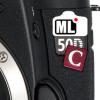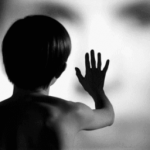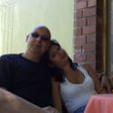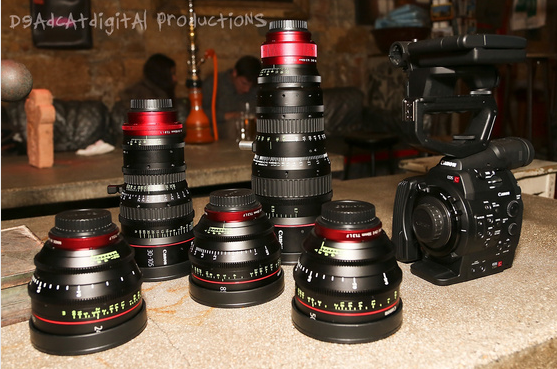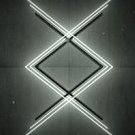Search the Community
Showing results for tags 'lenses'.
-
Eagerly awaiting your Pocket Cinema Camera? You already have a micro for thirds camera and some C-mount lenses? Want to know if they will cover the sensor of the Pocket? Lets find out! I hope you will add your results, so we can make this list growing. I will only add lenses to the lists when you have proof, in other words: images. How? Because we know the active sensor area of the BMPCC measures 12,48 x 7,02 mm, it is fairly easy to check if our C-mount lenses will cover the full sensor. Calculate this by taking a picture with a lens on your micro four thirds camera, and crop out the image area of theBMPCC. In Photoshop: Open the image. Go to Edit > Image Size, uncheck resample image. Change Image width to 19 centimeters, press ok Go to Image > Canvas Size, change dimensions to 12,48 x 7,02cm, press OK to crop the image to BMPCC size. Resize to 1920x1080 pixels Post your results! Note: If you shoot on the GH3 or other MFT camera's, the sensor size is 17 x 13mm, so change the width in step 3 to 17 cm! To lazy to do it yourself or you can't work it out? Upload the full resolution files and I'll do it. List terms explained: Yes = covers the full sensor of the Blackmagic Pocket Cinema Camera No = doesn't cover the sensor Needs modification = Doesn't fit on C-mount to M43-adapter without modifications Equivalent = The focal length and depth equivalent on a fullframe camera (5D Mark III for example) Blackmagic Pocket Cinema Camera Compatibility list Primes Apollo 25mm f/0.85 - Yes = 72mm f/2.4 equivalent [link to proof] Angenieux 10mm f/1.8 Retrofocus (Fixed Focus) - Yes (dark corners) = 28,8mm f/5.2 equivalent [link to proof] [more info] Carl Zeiss Jena Tevidon 10mm f/2 - Yes - Needs modification = 28,8mm f/5.8 equivalent [link to proof] [more info] Carl Zeiss Jena Tevidon 35mm f/1.9 - Yes - Needs modification = 101mm f/5.6 equivalent [link to proof] Century 9mm f/1.8 - YES (poor quality) [link to proof] Computar 8mm f/1.3 - NO [link to proof] Computar 16mm f/1.4 - NO [link to proof] Computar TV Lens 25mm f/1.8 - YES = 72mm f/5,2 equivalent [link to proof] Cosmicar 8,5mm f/1.5 - NO [link to proof] Cosmicar 12.5mm f/1.8 - YES - Needs modification = 36mm f/5.2 equivalent [link to proof] Cosmicar 25mm f/1.8 - YES - 72mm f/5.2 equivalent [link to proof] Ernitec 6.5mm f/1.8 - YES (heavy distortion) [link to proof] Ernitec/Navitar 17mm f/0.95 - YES (v. blurry corners & distortion) [link to proof] Fujinon TV 12.5mm f/1.4 - Yes (blurry corners) - Mod.? (unknown) = 36mm f/4 equivalent [link to proof] Fujinon TV 16mm f/1.4 - NO [link to proof] Fujinon TV 35mm f/1.7 - YES - Needs modification = 101mm f/4.9 equivalent [link to proof] Leitz Macro Cinegon 10mm f/1.8 - Yes (dark corners) = 28,8mm f/5.2 equivalent [link to proof] Kern Switar 10mm f/1.6 - Yes (slight vignette & blurry corners) [link to proof] Nikon Cine Nikkor 13mm f/1.8 - Yes = 37,5mm f/5.2 [link to proof] Nikon Cine Nikkor 25mm f/1.8 - Yes = 72mm f/5.2 equivalent [link to proof] Pentax 25mm f/1.4 - YES - 72mm f/4 equivalent [link to proof] Schneider 10mm f/1.8 (silver version) - No (almost) [link to proof] Schneider-Kreuznach Cinegon 11.5mm f/1.9 - No (almost) = 33mm f/5.6 equivalent [link to proof] Schneider-Kreuznach Cine-Xenon 16mm f/2 - Yes = 46mm f/5.8 equivalent [link to proof] [link to proof (2)] Schneider-Kreuznach Xenon 25mm f/0.95 - Yes = 72mm f/2.7 equivalent [link to proof] Schneider Xenoplan 17mm f/1.7 - Yes (blurry corners) - [link to proof] SLR Magic 11mm F1.4 - Yes - [link to proof] (added by EOSHD) Tokina TV Lens 8mm f/1.3 - NO [link to proof] Tokina TV Lens 16mm f/1.6 - NO [link to proof] Taylor-Hobson Cooke Kinic 25mm f/1.3 - Yes = 72mm f/3.7 equivalent [link to proof] Taylor-Hobson 25mm f/1.9 - Yes - 72mm f/5.6 equivalent [link to proof] Wesley 25mm f/1.4 - YES = 72mm f/4 equivalent [link to proof] Wollensak Cine Raptar 12.5mm f/1.5 - Yes = 36mm f/4.3 equivalent [link to proof] Wollensak Cine Raptar 25mm f/1.9 - Yes = 72mm f/5.6 equivalent [link to proof] $ 25 noname 25mm f/1.2 CCTV - YES = 72mm f/3.5 equivalent [link to proof] Zooms Ernitec 6-12mm f/1.4 - NO [link to proof] Kowa TV Zoom 12.5-75mm f/1.8 - NO [link to proof]
- 264 replies
-
- GH2
- cropfactor
- (and 6 more)
-
I'm really considering making a big upgrade to the URSA, but I've already invested in a fleet of Canon FDs. I've been doing some research on FD to PL mounts without a lot of luck. I know ARRI make an FD adapter to the ARRI mount (PL??) but besides that seems there's zilch out there. Some talk about machining the lenses to fit the new flange but I was hoping someone here knows of something...
- 5 replies
-
- black magic
- adapter
- (and 6 more)
-
Hello everyone, My name is Gleb, I'm starting a production company to shoot feature films, and commercials / music videos on the way before that. For my camera package for the first 2-3 feature films I'm going to buy GH4 as the camera body (Now have 2xGH3), and after I will have a transition to BMPC 4K and then to RED Scarlet / Epic Now I own a speed booster alternative RJ speed booster (Nikon mount) And was thinking about the idea of buying a full Rokinon cinema lenses set (Nikon mount) Than use it on the RED scarlet before buying better primes, but than I will not be able to have my middle switch from GH4 to BMPC 4k. 1.) So is it better to buy all lenses EF mount and buy the EF speed booster and than EF mount for RED cameras, or buy Nikon to EF adapters for the BMPC 4k? 2.) Another idea was to avoid speed booster and by ROKINON lenses in MFT mount direct, to partially avoid the crop factor, and after 2-3 films sell the full kit and buy PL Primes for BMPC 4k and then move to PL RED? 3.) For our second feature film we are planning to shoot anamorphic x1.5 adapters style, any ideas on working (Anamorphic / Rokinon / Speed Booster / GH4) or avoiding Speed Booster will be better? 4.) Buy one vintage PL zoom lens and a PL adapter for GH4? Any lens suggestions in that case please. Now I have only 2 nikon zoom lenses to use with my speed booster and I can sacrifice that if needed. Thank you for your answers!
-
Hello all! I would like to preface this post by saying that this is actually my first time on these forums, so thanks in advance for this awesome community. Also, I'm somewhat of an intermediate filmmaker, and you can check out my YouTube channel to see where I'm at (youtube.com/thisisrmm). As with the title of this post, I'm trying to figure out where my money would be better spent, upgrading to a 70D or buying more lenses? I have my own personal pros and cons for both, but first, here is what I currently shoot with: Canon t3i w/ Magic Lantern Canon 18-55mm (kit lens) Canon 50mm 1.8 I've set aside a budget of $1000 to make upgrades, so I'm not sure where my money is better spent. Reasons for upgrading to the 70D: - I eventually plan on upgrading to full frame in the future; not sure if buying desired lenses made for APS-C's like my t3i (Tokina 11-16mm) is worth the money if I'm upgrading - I can stick with this camera for longer, with it being a full frame (not having to worry about crop factors and what not) - From my own research, a better camera overall Reasons for buying lenses: - I'm pretty run-and-gun with my setup, so I've been somewhat relying a lot on the kit lens, which definitely helped me learn a lot about DSLR video, but I'm looking to take a step up in the category - Lenses definitely outlast cameras, so I figured that might be a better investment considering that I have this kind of budget set aside Cons for 70D: - If I buy this camera (body-only), the only compatible lens I'll have is the 50mm f/1.8 until I can afford to buy my desired lens of choice (Tamron 24-70mm f/2.8) Cons for buying lenses: - If I buy the Tamron 24-70mm, it'll be in somewhat of a weird crop for me to use with my t3i - If I don't settle with the Tamron, I'm somewhat lost on what lenses to buy within my budget that would work well on APS-C and eventually full frame whenever I make the upgrade I'm sorry for the lengthiness of this post, but just looking to provide as much detail as possible. Thanks to anyone willing to help a new guy out! Best, thisisrmm
-
I began discussing this in another thread, but it was off-topic, so here it is: I'm ready to invest in some primes for my GH3 (I've got the 12-35 and 35-100mm zooms). I do mostly handheld street shooting, but I would like to branch out into short films one day. Question 1: If I don't already own any legacy lenses, is there any advantage to buying full frame lenses + adaptors over u43 lenses like Voigt or SLR Magic (apart from cost?). Question 2: Are cheap adaptors fine for video use? Question 3: How about the Samyang/Rokinon cine lenses? Question 4: Also, right now, I'm already using a shoulder rig to keep my OIS lenses from jittering (initially, for the longer zoom, but now I use it with both lenses with great results); what is the longest lens I should realistically be able to use without having to do post stabilization? a 50mm?
-
I hope I can get some good advice from you - at least I'm sure I'm at the right place here. Ever since the G6 came out I'm having an eye on it's price. Unfortunately rumour has it that it's not produced anymore and also price drop is stagnating. Because of that I'm thinking of getting it soon. If I had the money, I of course would go for the 14-140mm bundle as a start and later on buy one or two primes to complete the kit but 750€ for the kit is just more than I want/can affort. I was looking for more affordable alternatives for that lens but it seems there are none. So I thought why not just get the G6 body for about 370€ and some old, even vintage lenses and a adapter along with it? I'd much prefer all manual lenses anyways (at least for photography), but although I've read quite a bit about it I simply have no clue which ones I should go for in specific or what adapter would be needed. I can tell you that lens size/weight doesn't matter to me and even that the lenses don't have to be top notch - but I also don't want to waste my money on crap. In the long run I might even get a speedbooster so the lenses you suggest should be ok with but also without one and just using a adapter instead (as that's how I'm going to start) and preferably the same lens mount. Of course that's another story if a lens is available for 30-40€ only - then the mount is not that important as long as there is an adapter. I'd be using the G6 for indoor videography - with more than enough lighting though. To give you an idea what lenses could be needed, here's what I'm using it for: I'm mainly filming products from a distance of about 1-2 meters The objects usually are below 10cm wide/high/deep There's basically only two options to film such a product: Either them alone, all over the screen or along with my forearms and hands holding/moving it. But I also would use it for photography and I appreciate a nice bokeh in most cases for: the products I'm filming, of course portraits of course the standard family/friends pictures every now and then I want to get into night sky - astrophotograpy (milkyway, so no extrem zooms but a wide angle lens), also time lapses of that street life/nature photography is something I'm doing rather seldom Ok, I really hope you guys can help me with lens suggestions as I just don't like the idea of getting the standart zoom bundle. Hopefully the lense junkies in this forum will assist me with their knowledge. Every answer helping me with my decision is very appreciated.
- 29 replies
-
- Panasonic G6
- G6
- (and 4 more)
-
Great news! Kowa re-entering the cinema business :) http://www.43rumors.com/new-kowa-micro-four-thirds-cine-lenses-announced/ 8.5mm T/3.0 12mm T/1.9 16mm T/1.6 25mm T/1.9 50mm T/2.1
-
Hey, I need suggestions which manual 50mm prime lens to pick up. I shoot with an APS-C Canon DSLR and a Panasonic GH3. Right now I have two 50mm lenses, one being the Canon 50mm f/1.8 and the other one being a Rikenon 50mm f/1.7. I also have the MFT Olympus 45mm f/1.8. Now I know that there's a ton of cheap, old 50mm primes but I don't know which one to pick up. The Canon is alright but isn't really useful when shot wide open because of purple fringing and general lack of sharpness. The Rikenon 50mm f/1.7 is a bit better wide open, so I'd just use this one BUT there's not stops between f/1.7 and f/2.8, which is really annoying. So I'm looking for a 50mm lens that is fairly useful wide open, has f-stops inbetween wide open and f/2.8, isn't too expensive and has a nice build quality. A local shop sells the Yashica 50mm f/1.7 for crazy cheap but I've heard mixed things about it. Is the Yashica 50mm f/1.4 better than the f/1.7 version? What about the Super Takumar 50mm f/1.4? How do these compare? And any other option that I should be looking into? Thanks a ton in advance, Moritz
-
I'm looking to learn how to fully clean/repair lenses more than simply puffing with a blower and wiping with a cloth... I have a bunch of old P entax SMC lenses that I don't mind pulling apart (two of them have a little fungus) and want to use them to practice repairing old manual primes. Unfortunately I can't find much online, nor any books on the topic. I have even tried to find information on specific lenses (Pentax, Nikkor etc.) but still nothing detailed. So essentially I am asking if anyone knows of books/websites etc. here I might be able to learn anything related to pulling lenses apart, cleaning/repairing them, and putting them back together again (all stages being vital!). I understand that this is as much a science as a skill, with precision and math being vital... but surely the talented folks repairing lenses haven't all learnt through apprenticeship? I've been pulling apart and re-assembling things since I was a kid (to various degrees of success), and sooner or later I'm just going to dive in... so please educate me before I make a mess!
-
Have been seriously considering this lens for my GH3 and (eventually) the BMPCC - though I can't seem to find any non-nature/event footage to get an idea of how it performs when shooting narrative work... The focus-by-wire and electronic aperture will be a pain for video shooting also... But the 12-35 range is really appealing (esp for the BMPCC). Anyone have any experience with this lens beyond test videos and home movies? Is it possible to create cinematic images with it under the right conditions, or are primes the only way to go? And if so, what would be an ideal prime lens set for the BMPCC (regarding focal length, not brand/model)?
-
looking to purchase an industrar 61L 50 mm lens for my panasonic gh2. was wondering what adapter i should go with for this lens. any recommendations or insight would be helpful! thanks so much!
-
I'm looking for a wide angle lens to compliment my collection of Nikkor AI-s primes, the widest of which is currently a 24mm 2.8 AI-s (used on D5300 and G6 with Speedbooster - so Super-35mm crop). Obviously I need something wider and there aren't really any decent manual prime options. It sounds like the Rokinon/Samyang 14mm isn't up to much. I've narrowed it down to the Sigma 10-20mm f4-5.6 and the Tokina 11-16 f2.8. I'm currently leaning in favour of the Sigma. It's main use will be with my new monoCam (Glidecam style stabiliser), so communication with my D5300 will be handy for auto exposure (i.e. no touching the lens/camera while flying the stabiliser). Because I'll have it stopped down for use with the monocam, I won't usually need the extra speed of the Tokina (which looks pretty soft wide open anyway). The Tokina looks like it is sharper than the Sigma, but not by much at the apertures I'll be using it at. I prefer the look of the images I've seen taken with the Sigma, and I like the extra focal range. Any advice/suggestions/experience before I go ahead and buy the Sigma?
-
I'm starting a video production company. I've worked in the mainstream feature film and TV production industry for almost 2 decades. Although I've spent countless hours around shooting crews over the years but I am not a DP so am looking for input. I'll be shooting some industrial videos but mostly short (1-5 min) scripted content for online distribution. We'll have to move fast to make our days, monopods and handheld where possible. I'm thinking of buying two Canon 70D bodies and have options when it comes to lens packages to start with. I want the option to shoot two cameras, one wide, one tight. I don't like to zoom in camera but like the zooms because I can avoid lens changes during production. Option 1: Canon 50mm f1.8, Tamron 17-50mm f2.8, Canon 85mm 1.8 EF Option 2: Canon EF 20mm f2.8, Canon EF 35mm f2.0, Canon EF 50mm f1.8, Canon EF 85mm 1.8 Option 3: Two Tamron 17-50mm f2.8 lenses and a Canon EF 85mm f1.8 I like option 2 because it's all primes but am thinking option 3 may be more efficient. I want to avoid manual focus pulling where possible and use the touch screen and focus capabilities of the 70D. I also have a SMC Pentax 50mm f1.4 with an adapter which is fully manual. I value any and all input.
-
I've been stewing about what lenses to invest in with my upcoming BMPCC order and thought maybe you guys could weigh in with your collective wisdom. I was leaning toward Nikkor AI-S glass because it was the pinnacle of manual lens tech in the manual lens photo heyday, has long focus throws, is relatively portable, and is flexible if I want to jump up to larger sensors in the future (does anyone think this 16mm sensor will stay around indefinitely?). Also, I could then hack an APS-C and a FF Canon for RAW and have three focal lengths for each lens, effectively. Or I could get the Metabones Speedbooster essentially making it a Super 35mm equivalent, more or less. Then I read one perspective that since using FF glass on the Micro Four Thirds BMCC and BMPCC sensor is cutting into the center of the glass means it will magnify all the imperfections of the lens. A friend I trust on technical matters agreed with this, saying Nikon glass would look bad no matter how good the original optics and the Speedbooster just adds more glass distorting the image. He seems to think the better approach is to get super 16 C-Mount glass designed for the sensor size, and then sell it if I change to a larger sensor camera .. kind of a "get what you need now for optimal results, and don't think about five years from now" mindset. I'm now leaning this way, thinking that the super wide focal lengths I'll need for the BMPCC and BMCC will be useless to me anyway if I decide to go with a larger sensor in future (I'm not into superwide lenses). Anyway, any thoughts would be much appreciated! TL;DR: I want future proof and flexible glass that will still shine on the BMPCC. Is this possible or should I go with optimized C-mount or M43 glass?
-
Hi all, I've been hesitating forever of even thinking about starting the long process of collecting lenses, due to the inertia that the neverending onslaught of new technology brings. There are so many promising directions this whole world could go, from the super-16 BMPC to the full-frame Canon 5D Mark III RAW, so my current thinking is that it's most sensible to go with the largest coverage format (full frame) and collect lenses from there, and then if the market settles anywhere (super 35, full frame, APS-C), you won't have obsolete glass lying around. I'm looking for as many people as possible to poke holes in the intuition or offer different plans as my current one: I've been thinking lately about collecting Nikon AI-S lenses, since they are the final (and presumably, best?) generation of Nikon manual focus glass. Some advantages as I see it are: adaptibility to the largest range of lens mounts long-focus throw age-related image character je ne sais quoi good build quality relatively cheap relatively compact Nikon quality (perceived? Is Canon just as good/better? Does Canon have an equivalent AI-S-era option that would work on current Canons?) Nikon-optimization, as I prefer Nikon for stills work Cheap adapters can control aperture, as opposed to Canon mount Fast Some disadvantages that I would imagine: Breathing and every other problem inherent in stills-optimized/non-cine lenses Difficulty finding cheap super wide options that would translate to normal lenses on much smaller sensors (Super 16, M43, BMCC, 1") Futility of collecting for BMPC when you end up settling on a 5DIII and have all these useless super-wides I'm sure a lot of people on here have thought a lot harder than I have about this quandry, or have skin in the game already, so if anyone has some personal experience or insight on how the filmmaking community is currently addressing this issue, please contribute any and all wisdom! What are general lens collection strategies to maximize utility and minimize cost? Is it presumed that lenses will hold value, so you can just sell them off with minimal long-term losses? Are there lenses that better meet ones needs? Would Canon make more sense, since a follow focus will allow for long focus throws anyway? Are there cheaper options (Contax (Zeiss), for example?) One caveat: I shoot stills as well. Is it ridiculous to think that shooting manual focus on all my various stills cameras (NEX-7, GH2, frequent Nikon rentals) is possible, and that I'd need to invest in a second set of AF stills camera (obviously this is a nuanced question, as different photography genres have different needs, but my work does include street photography).
-
Hey guys, Made up my mind to sell some of my gear. PM me if interested in any of the following. Kowa 16H 2X anamorphic adapter - good condition Canon FD 20mm f2.8, 35mm f2, 50mm f1.4, 85mm f1.2 lenses - all in good condition Canon FD to MFT adapter - new Slr Magic 12mm f1.6 - new Slr Magic 25mm f0.95 - new Voigtlander 17.5mm f0.95 - new Thanks!
- 1 reply
-
- KOWA
- anamorphic
-
(and 8 more)
Tagged with:
-
Different lenses for sale: (EDIT-VOIGT 17.5mm SOLD) KOWA 2X http://www.ebay.com/itm/Kowa-Prominar-1 ... 2a2e6423e5 SLR Magic 12mm f1.6 http://www.ebay.com/itm/SLR-Magic-Nokto ... 2a2e643a79 SLR Magic 25mm f0.95 http://www.ebay.com/itm/SLR-Magic-Nokto ... 2a2e644fa6 All like new except the Kowa 2X anamorphic. I'm getting rid of them cause I never used them and I rather have the money. I tried returning them but Noktor has a strict return policy (no returns).
-
A 25mm & 35mm, modified by Duclos with Cine lens features. Nikon mount. Also selling Tokina 11-16. http://www.ebay.com/sch/voyagervideo/m.html?_nkw=&_armrs=1&_from=&_ipg=&_trksid=p3686
-
Hi, just wanted to start a topic about using 3rd party lenses with the Metabones Speed Booster. Their website warns about the possibility of some lenses having protruding rear elements that could scratch the adapter or short out the electrical connections. I don't yet own any EF lenses, so I'm currently using a Rainbow Imaging Nikon to EF adapter. The lenses I've tried with this are: - 50mm f/1.8 pancake (all manual) - 24mm f/2 AIS (all manual) Camera is a Sony NEX-5n. After my first day of trials, this combo works fine. My caveats so far: - The Nikon adapter tends to stick to the lens, requiring a manual depress of the delicate release lever in order to unscrew it from the lens. So I'm just buying another Rainbow Imaging adapter and plan on leaving it on the lens all the time. - The lens focuses a bit past infinity. Other than that, I'm really enjoying the Speed Booster and see no image degradation. Will be posting sample videos soon. Anyone else tried other lenses?
-
- metabones
- speed booster
-
(and 7 more)
Tagged with:
-
https://vimeo.com/55803392 Produced by http://www.Deadcatdigital.com Location: "Szimpla kert" ruin pub Budapest - http://www.szimpla.hu 11.12.2012 ISO: 2000-6000 1080i 4:2:2 MXF No color correction in post Canon EF Cinema lenses we used: 24mm T1.5 50mm T1.3 85mm T1.3 Music: Infected Mushroom-Muse Breaks RMX [attachment=327:Canon_c500_deadcatdigital_cinema_lenses.png]
-
[url="http://blogs.zeiss.com/photo/en/?p=2860"]http://blogs.zeiss.com/photo/en/?p=2860[/url] For those with money to burn (or the rental houses), new high-end Zeiss primes for Canon and Nikon. These resemble the Hasselblad medium-format lenses in size and construction. Pretty spectacular things!
-
I have one question that has been creeping out since the announcement of the m4/s mount. Originaly I have planned to use my set of Samyang lenses (8, 24, 35) and Tokina 11-16, all EF mount as the main lenses for the BMC. Now with the announcment of m4/3 all world of lenses that I have used on GH2 opens up, including my absolute favorite LOMO OCT 18 mount russian lenses, however my dilemma is, if I opt to get m4/3 camera would I see any difference on my EF lenses (as opposed to going with the original mount for BMC) as well as how to change the aperture on my Tokina (as that would have to still be my main lens for BMC)? Would it be better to just go for ZE/EF or for m4/3 in my situation? Thanks a lot!
- 5 replies
-
- bmc
- blackmagic
- (and 4 more)
-
Hi, I want to buy new 50mm fast prime. I will be using the lens on my gh2 and on BlackMagic cinema camera for now. I m debating between the these two: 1. Customized pro full-frame film lens cinematics Pentax PHN50/1.7 PK - for $500 2. Canon EF 50mm f1.4 - for $400 Would anybody have any suggestion on which lens should I buy. Thank you very much for your insights and your time. Cheers!

